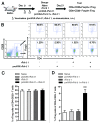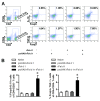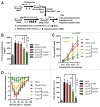Fel d 1-airway inflammation prevention and treatment by co-immunization vaccine via induction of CD4+CD25-Foxp3+ Treg cells
- PMID: 23324570
- PMCID: PMC3899136
- DOI: 10.4161/hv.23518
Fel d 1-airway inflammation prevention and treatment by co-immunization vaccine via induction of CD4+CD25-Foxp3+ Treg cells
Abstract
Pet allergens are major causes for asthma and allergic rhinitis. Fel d 1 protein, a key pet allergen from domestic cat, can sensitize host and trigger asthma attack. In this study, we report that co-immunization with recombinant Fel d 1 protein (rFel d 1) plus plasmid DNA that contains Fe1 d 1 gene was effective in preventing and treating the natural Fel d 1 (nFel d 1) induced allergic airway inflammation in mice. A population of T regulatory cells (iTreg) exhibiting a CD4+CD25-Foxp3+ phenotype and expressing IL-10 and TGF-β was induced by this co-immunization strategy. Furthermore, after adoptive transfers of the iTreg cells, mice that were pre-sensitized and challenged with nFel d 1 exhibited less signs of allergic inflammation, AHR and a reduced allergic immune response. These data indicate that co-immunization with DNA and protein mixture vaccine may be an effective treatment for cat allergy.
Keywords: Fel d 1; T regulatory cell; airway inflammation; co-immunization; vaccine.
Figures









Similar articles
-
Protein/DNA vaccine-induced antigen-specific Treg confer protection against asthma.Eur J Immunol. 2008 Sep;38(9):2451-63. doi: 10.1002/eji.200737899. Eur J Immunol. 2008. PMID: 18792401
-
Induction of immune tolerance in asthmatic mice by vaccination with DNA encoding an allergen-cytotoxic T lymphocyte-associated antigen 4 combination.Clin Vaccine Immunol. 2011 May;18(5):807-14. doi: 10.1128/CVI.00434-10. Epub 2011 Feb 23. Clin Vaccine Immunol. 2011. PMID: 21346053 Free PMC article.
-
Contribution of regulatory T cells to alleviation of experimental allergic asthma after specific immunotherapy.Clin Exp Allergy. 2012 Oct;42(10):1519-28. doi: 10.1111/j.1365-2222.2012.04064.x. Clin Exp Allergy. 2012. PMID: 22994349
-
Luteolin attenuates airway inflammation by inducing the transition of CD4+CD25- to CD4+CD25+ regulatory T cells.Eur J Pharmacol. 2018 Feb 5;820:53-64. doi: 10.1016/j.ejphar.2017.12.003. Epub 2017 Dec 7. Eur J Pharmacol. 2018. PMID: 29225189
-
Foxp3 expressing regulatory T-cells in allergic disease.Adv Exp Med Biol. 2009;665:180-94. doi: 10.1007/978-1-4419-1599-3_14. Adv Exp Med Biol. 2009. PMID: 20429425 Review.
Cited by
-
DNA and mRNA vaccination against allergies.Pediatr Allergy Immunol. 2018 Nov;29(7):679-688. doi: 10.1111/pai.12964. Epub 2018 Sep 20. Pediatr Allergy Immunol. 2018. PMID: 30063806 Free PMC article. Review.
-
Indoor-air purification by photoelectrochemical oxidation mitigates allergic airway responses to aerosolized cat dander in a murine model.Sci Rep. 2023 Jul 6;13(1):10980. doi: 10.1038/s41598-023-38155-0. Sci Rep. 2023. PMID: 37414804 Free PMC article.
-
Allergens are not pathogens: why immunization against allergy differs from vaccination against infectious diseases.Hum Vaccin Immunother. 2014;10(3):703-7. doi: 10.4161/hv.27183. Epub 2013 Nov 26. Hum Vaccin Immunother. 2014. PMID: 24280693 Free PMC article. Review.
-
Studies on nanoprotein vaccine alleviating symptoms of mice allergic to rFel d 1.Front Immunol. 2025 May 26;16:1524929. doi: 10.3389/fimmu.2025.1524929. eCollection 2025. Front Immunol. 2025. PMID: 40491911 Free PMC article.
-
Modulating Shrimp Tropomyosin-Mediated Allergy: Hypoallergen DNA Vaccines Induce Regulatory T Cells to Reduce Hypersensitivity in Mouse Model.Int J Mol Sci. 2019 Sep 19;20(18):4656. doi: 10.3390/ijms20184656. Int J Mol Sci. 2019. PMID: 31546958 Free PMC article.
References
MeSH terms
Substances
LinkOut - more resources
Full Text Sources
Other Literature Sources
Medical
Research Materials
Miscellaneous
